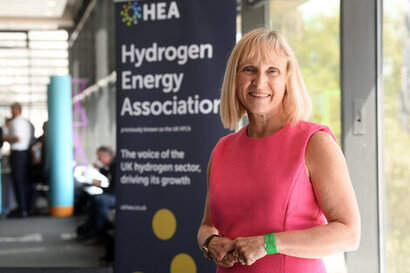WOBO is please to provide energy news from “Renewable Energy”

Minnesota Development Awarded $4.7M for Geothermal Energy System
The Minnesota Climate Innovation Finance Authority (MnCIFA) awarded a $4.7 million loan, the first for MnCIFA, to The Heights Community Energy, who plans to construct and operate a district geothermal energy system at The Heights development on the East Side of Saint Paul.
“Using the Earth’s natural energy to heat and cool a whole community is a big step toward achieving our local climate goals,” said Mayor Carter. “Together, with the support of MnCIFA and our partners at the Port Authority and District Energy, we’re building a neighborhood that can be a blueprint for a cleaner, more sustainable future.”
Ward 6 Councilmember Nelsie Yang said, “The Heights is truly a once- in- a- lifetime investment to the East Side of Saint Paul. With the addition of a geothermal energy system, we hope to achieve the creation of sustainable, energy-efficient homes and close the clean energy divide by eliminating the burden of high utility bills and increasing access to the tools that’ll help communities lower their carbon footprint. This is a precedent for what is to come. I look forward to continuing to work with community leaders and all of our partners in advancing towards environmental and climate sustainability for all.”

HEA calls for hydrogen to play greater role in decarbonisation of construction machinery
In a response to the DESNZ and DfT consultation on non-road mobile machinery (NRMM), released by the Hydrogen Energy Association (HEA), the organisation, which represents 120 leading hydrogen businesses across the full value chain, said the Government’s vision understates the opportunity for hydrogen in comparison to electrification.
The HEA called for a more “holistic approach” and said the “government must give more foresight to a pragmatic, long-term roadmap that details specifically how NRMM will be supported in achieving the endpoint of Net Zero by 2050.”
In the response, which addresses a series of questions raised by Government, CEO of the HEA Celia Greaves said hydrogen is well suited to the high energy output and flexibility demands of Non-Road Mobile Machinery.

New Report Shows More than 10GW of Storage was Deployed in 2023
The European Association for the Storage of Energy (EASE) and LCP Delta have announced publication of the eighth edition of the European Market Monitor on Energy Storage (EMMES). The Market Monitor is an interactive database that tracks over 3,000 energy storage projects.
With information on assets in over 29 countries, it is the largest and most detailed archive of European storage. The database is accompanied by a report which outlines key EU legislation, drivers and barriers for 14 core countries. The report looks at the electrical energy storage market, providing data and analysis across three market segments (residential, commercial & industrial and Front of the Meter) with updated project data based on StoreTrack database and a forecast towards 2030.

New research from Saïd Business School at the University of Oxford has found that smart meters can significantly increase energy conservation efforts in that real-time information on people’s energy usage is more effective in encouraging energy conservation than making users aware of the environmental impact of their usage.
The study, undertaken by Ximeng Fang, a Postdoctoral Research Fellow at Saïd Business School, alongside researchers from a number of global institutions, found that, when applied alone, smart meters – which offer users real-time data on their energy usage – were effective in encouraging households to conserve energy when showering. Information on users’ environmental impact, delivered through a shower report offered via email, meanwhile, was ineffective when used on its own.
However, the researchers found that these methods, when used together, were considerably more effective in encouraging energy conservation than when either was used in isolation.

The transformation of our energy system is in full swing: renewable energies are in the process of overtaking fossil and nuclear fuels in power generation. In order to become the mainstay of the energy system and guarantee a 24/7 energy supply with renewables, we now also need a new system architecture. And that means making renewables available as effectively as possible at the time and place when, where and how they are needed, whether as electricity or heat. Many of the solutions for this are already in the starting blocks and we would like to present some of them to you today – be it product developments in photovoltaics such as new cell technologies or in energy storage systems and charging stations for e-mobility. Or business and marketing models such as PPAs or flexible electricty prices.
Want to find out more about the energy system of the future?
Join us at The smarter E Europe 2024! https://www.intersolar.de/tickets?

New Technique Converts Excess Renewable Energy to Natural Gas
Four Lawrence Livermore National Laboratory (LLNL) researchers have partnered with Los Angeles-based SoCalGas and Munich, Germany-based Electrochaea to develop an electrobioreactor to allow excess renewable electricity from wind and solar sources to be stored in chemical bonds as renewable natural gas.

Weltec Biopower’s First Kumac Plant in Germany Goes Live
In March 2024, Agrar GmbH Reichenbach commissioned its Kumac digestate processing system from WELTEC BIOPOWER. This is the first Kumac plant to go live in Germany, in addition to the 16 that have been built worldwide to date. The agricultural company based in the Vogtland region of Saxony, Germany, specializes in dairy farming and the cultivation of feed crops. In addition to the dairy farm with 1,400 cows and breeding cattle, the farmers have been operating a biogas plant with an electrical output of 845 kW since 2006. The facilities generate up to 72,000 t of liquid manure and digestate per year
